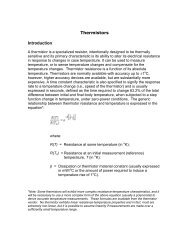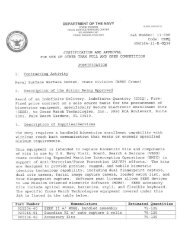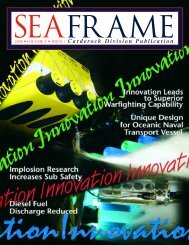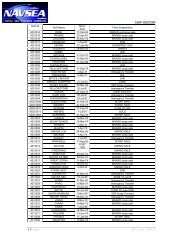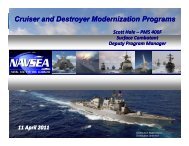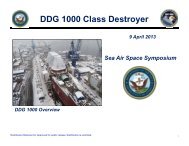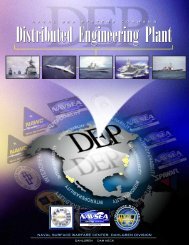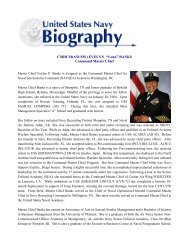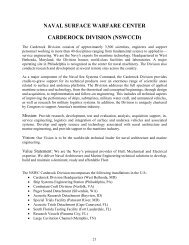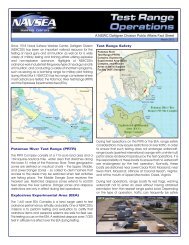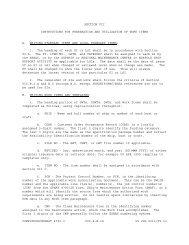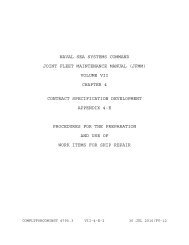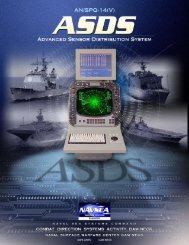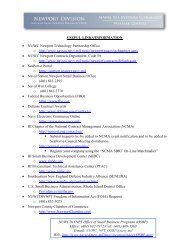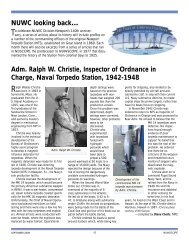Volume 6, Issue 1 - Naval Sea Systems Command - The US Navy
Volume 6, Issue 1 - Naval Sea Systems Command - The US Navy
Volume 6, Issue 1 - Naval Sea Systems Command - The US Navy
Create successful ePaper yourself
Turn your PDF publications into a flip-book with our unique Google optimized e-Paper software.
SEAFRAME<br />
26<br />
By<br />
William<br />
Palmer<br />
Core equities<br />
In 2006, the Secretary of the <strong>Navy</strong>,<br />
Dr. Donald C. Winter, announced an initiative<br />
to enhance the Department of Defense’s ability<br />
to perform modeling and simulation, expecting<br />
the initiative to have a beneficial impact on such<br />
activities as ship design and acquisition. Shortly<br />
after the initiative was launched, the High Performance<br />
Computing Modernization Office initiated the Computational<br />
Research and Engineering for Acquisition Tools and<br />
Environments (CREATE).<br />
CREATE consists of three projects: Ships, Antennas<br />
and Aviation. Within the Ships project there are four products,<br />
one of which uses modeling and simulation software–written<br />
in a combination of C++ and Fortran 90–to predict the effects<br />
of underwater explosions, or UNDEXs, shock effects and<br />
damage resulting from such events. A team of experts from the<br />
<strong>Naval</strong> Surface Warfare Center (NSWC), Carderock Division,<br />
consisting of Dr. E. Thomas Moyer, one of 28 <strong>Navy</strong>-wide<br />
Senior Research Scientist, mechanical engineer Ray DeFrese,<br />
and Dr. Mary Vechery, heads up development efforts, both inhouse<br />
and in concert with personnel from NSWC Indian Head<br />
Division and Sandia National Laboratories.<br />
<strong>The</strong> team’s goal is to develop the next-generation<br />
modeling and simulation software for specific applications,<br />
in this case shock and UNDEX events. To accommodate the<br />
computation-intensive tasks CREATE would have to perform,<br />
both high-performance computing resources and the expertise<br />
COMPUTATIONAL<br />
RESEARCH AND<br />
ENGINEERING FOR<br />
ACQUISITION TOOLS<br />
AND ENVIRONMENTS<br />
Predictive Software that Should Save<br />
Money on UNDEX Trial Costs<br />
of personnel knowledgeable about the dynamics of shock<br />
impact energy on a structure had to be applied. “<strong>The</strong> actual<br />
software development started in FY 08,” said Moyer, “and<br />
we’re leveraging heavily off of existing code, such the Sandia<br />
Lab Salinas code, Indian Head’s Gemini code, and general<br />
LaGrangian routines. We are adding to these programs, not<br />
rewriting them.”<br />
Another challenge for the team is to add the<br />
unique modeling and simulation needs of the <strong>Navy</strong> to the<br />
assembled collection of computer applications. Products from<br />
the Department of Energy’s (DOE’s) Advanced Scientific<br />
Computer program, which CREATE uses, address analysis<br />
of solid structures, for example, but needed enhancement<br />
(e.g., shell elements) because of the specific requirements<br />
of the naval shock environment. Another needed feature of<br />
DOE applications is what Moyer terms “massively parallel”<br />
computing systems, meaning that several computing tasks are<br />
executed simultaneously, or in parallel, greatly increasing the<br />
efficiency of the systems and the accuracy of their output.<br />
High-level <strong>Navy</strong> officials have put their support<br />
behind CREATE. <strong>The</strong> CREATE Ships board of directors,<br />
chaired by Rear Admiral Thomas J. Eccles, has recently<br />
signed the Initial Capabilities Document, which describes<br />
capabilities the software is expected to achieve. A<br />
memorandum of agreement among the various program<br />
offices and their sponsors is being developed to formalize<br />
the relationship between the CREATE Ships project and the



